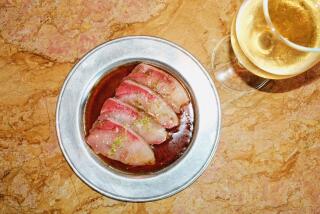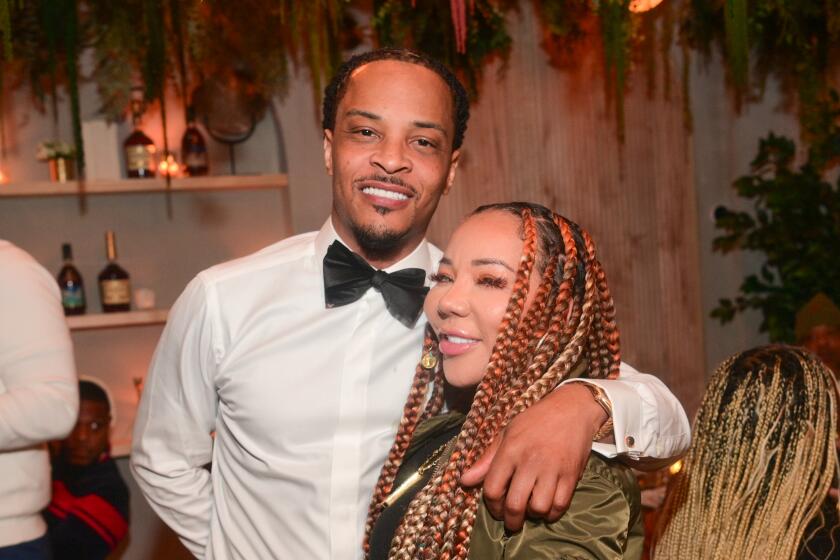Night Life: Julian Cox shakes up L.A.’s cocktails scene
It’s 5:45 p.m. on a Thursday and Julian Cox hasn’t eaten a thing, which is odd since he works in some of the best restaurants in town. He is one of Los Angeles’ top mixologists, and he runs the cocktail programs of chef John Sedlar’s Rivera and Playa as well as Sotto and chef Ricardo Zarate’s just-opened Peruvian restaurant, Picca. It’s at Picca that he finds himself both starving and unable to eat because he is zesting oranges to mix with sugar to rim the glasses for a drink he created called the Rhubarb Sidecar.
“15 minutes ‘til service!” shouts Picca’s managing partner, Stephane Bombet, rushing through the chaotic dining room, past servers urgently folding napkins, prep cooks placing fish and fresh vegetables at the open ceviche bar, and Cox’s bar team, whom he has been training for weeks. Though Picca wasn’t officially open for business at the time, that night more than 200 diners were expected to pour through its wide doors for a reunion dinner for the Test Kitchen — a much-lauded pop-up restaurant that hosted a rotating cast of some of the most respected chefs and mixologists in town. Cox was Test Kitchen’s beverage director.
Tonight will be all about his drinks and Zarate’s food. If Cox, 29, has done his job right the two should go together like gin and tonic. It’s a job he takes seriously, often nabbing ingredients and tools from the kitchen to use in his drinks. And he’s not alone. Mixology fever has gripped the city in the last several years, with bartenders and bar consultants such as Eric Alperin at Varnish, Marcos Tello at 1886, Aidan Demarest at the Spare Room, Zahra Bates at Providence, Vincenzo Marianella at Copa d’Oro and Tricia Alley at Black Market Liquor Bar in Studio City, elevating the cocktail to the level of culinary art. They aretransforming the L.A. restaurant landscape, to the point that what’s in your glass is now as important as what’s on your plate.
“I’ve never seen mixology at this level, and I’ve never seen mixologists busting boundaries as they are in today’s restaurant environment,” says Sedlar, whose groundbreaking Latin cooking has captivated Los Angeles for decades. “It’s a real win-win for the restaurateur and the guest and adds a new direction to dining that wasn’t there before.”
It takes months to prepare a mixology-level beverage program for a restaurant, and Cox has done three in the last six months — creating 37 cocktails. In addition to skipping meals, he’s missing time with his fiancée and 7-month-old son and losing sleep — often working seven days a week for 10 hours or more. This streak began in December, when he hired 22 new bartenders to go through an intensive six-week training course, beginning with the basic Prohibition-era cocktails like Manhattans and Old Fashioneds, and moving into increasingly complex techniques, including molecular gastronomy such as making “strawberry air” to top off a drink called the Martin Ricky.
Strawberry air is made by putting fresh farmers-market strawberries through a juice extractor and then mixing in a powder called Versawhip with an immersion blender. A bit of ascorbic acid is also added to preserve the rosy pink color.
For his Picca trainees, Cox, an avid reader of cookbooks, is scenting eggs with cinnamon essence so that when they are cracked for an egg white-based drink like the Pisco Sour, they smell and taste like cinnamon.
The process, which riffs on an old French trick of storing eggs with truffles, is laborious, as is much of the prep work for his bars. He takes brown, free-range, organic eggs and uses a dropper to put food-grade essence onto cotton balls, which he then packs with the eggs in an air-tight container. He tops the whole thing with a single cinnamon stick and refrigerates it for two days. The final effect in the glass is a subtle cinnamon nose and a whisper of flavor.
“These are the things that the customers don’t realize, but it makes all the difference in a cocktail,” says the tall and baby-faced Cox, dressed in a plaid shirt, jeans and a white apron. He and his team of three women and two men have been prepping for four hours — making fresh anise, cinnamon and cardamom syrups, juicing lemons and limes, cleaning and stocking the bar, polishing copper mugs.
“One of our mantras is that you can mess up a cocktail by the width of a nickel,” says trainee Jamie Schreiber, who has a master’s in anthropology but decided to take time off before her doctorate to bartend. “It’s all about consistency. Julian wants a drink that I make to taste exactly like a drink that he makes.”
And that can be hard to do, because Cox is constantly tinkering. He’ll talk with his chefs, taste their food, scour farmers markets and the kitchen for ingredients and then disappear, into what he calls his “Drink Tank,” with a few collaborators.
“We all sit down with our calculators and computers and figure out how to do it right,” says Cox. Take a drink on Picca’s menu called the Avocado Project, which Cox is still experimenting with on the night of the Test Kitchen reunion. It’s made of avocado, ginger, agave nectar, lime and rum and sprinkled with salt. Cox shows the group how to make it, but a day before opening, he will make it differently.
“That’s why it’s called a ‘project,’” he jokes.
It was Sedlar who essentially discovered Cox. It was 2008, and Cox, who is from Missouri and won his first cocktail competition in 2006, was mixing at David Myers’ lauded French restaurant Comme Ça. He had recently fled the Red Bull-and-vodka littered vistas of Hollywood for the program, which was put together by a team from famed New York mixologist Sasha Petraske’s Milk & Honey. Sedlar was scouring the city — and the country — for the right mixologist to help him open Rivera, his nuevo Latin restaurant.
“I was a fly on the wall,” says Sedlar, who visited Comme Ça a number of times before introducing himself. “And I watched how he articulated the vocabulary of the cocktail behind the bar.” When the men had their first meeting at the Coffee Bean at the Grove, Cox said he was relieved because Sedlar didn’t want to do typical Latin cuisine like paella and tacos.
“I said great, I don’t want to do margaritas,” remembers Cox.
Soon Sedlar flew Cox to Mexico where he has an agave farm. “We got him in the soil, splitting the corazones and getting a feel of the earth — the volcanic, blackish-red color — it’s high in copper and iron and you understand what the sun does to the starches in the plant.”
Having been immersed in the culture of tequila, Cox returned to create a cocktail list that Sedlar says grabbed attention for Rivera right out of the gate. One such drink, called the Donaji, is rimmed with chopped chapulines (grasshoppers) mixed with salt.
Zarate too says that Cox’s cocktail list is essential to the future of Picca, so much so that the drink menu is the first thing that is left on the table for a new guest. With all the prep work done in advance, the drink should come out fast, and it will set the tone for the food to come.
When the doors finally open for the Test Kitchen reunion, there is motion and chaos. It’s not quite the “symphony of cocktailing” that Cox aims for, but he feels certain that in a few days his team will catch their stride.
“Make me believe that we’re ready to open,” Cox says to his staff. “Whatever you have to do.”
More to Read
The biggest entertainment stories
Get our big stories about Hollywood, film, television, music, arts, culture and more right in your inbox as soon as they publish.
You may occasionally receive promotional content from the Los Angeles Times.











